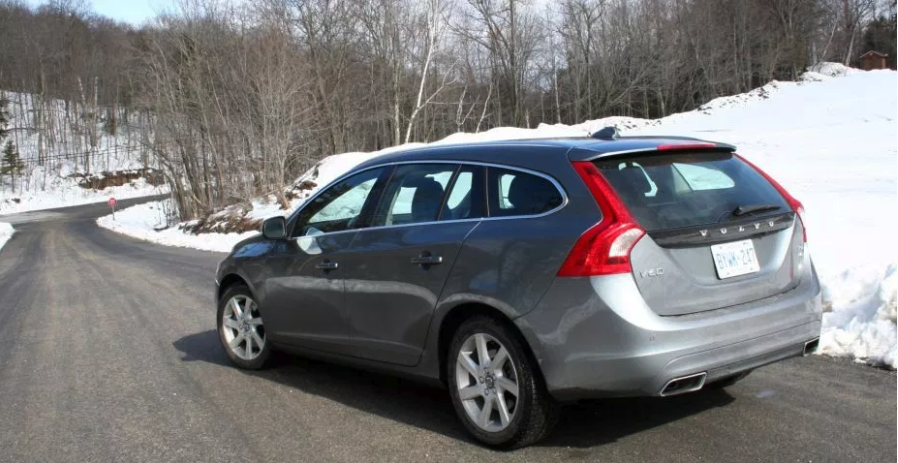Long-Term Test: 2016 Volvo V60 Sportwagon – Part 3

Story and photo by John LeBlanc
If safety and practicality are at the top of your next new vehicle wish list, we can see how easy it would be to gravitate to our current 60-day tester, the 2016 Volvo V60 Sportwagon.
In our last installment, we found our 2016 Volvo V60 Sportwagon ($55,850 as tested) to be a practical human and cargo hauler for a family skiing holiday. And along with being a very stylish and competent mode of transport, we’re discovering how much the compact Volvo wagon upholds the Swedish automaker’s reputation as a creator of some of the safest new vehicles you can put your family into.
As much as station wagons and Volvo go together like saffransbullar and pepparkakor, so does state-of-the-art automotive safety. Between introducing the three-point safety belt in 1959 to the automaker’s current mission that by 2020 no one should be killed or injured in one of its vehicles, safety has always been a Volvo hallmark. The 2016 V60 Sportwagon is no exception.
Marketed under Volvo’s Intellisafe umbrella, our V60 Sportwagon T6 Drive-E AWD Premier comes with a slew of standard safety features new vehicle buyers can now take for granted, like multiple airbags, anti-lock brakes and electronic stability and traction control systems. More impressive is the automaker’s so-called City Safety preventative forward crash technology, first seen on the 2010 XC60 rossover and now standard on every model.
To recap: City Safety detects if the speed between your vehicle and the vehicle ahead is less than 15 km/h, and decides if a crash is imminent. If the driver does not respond to the system’s flashing head-up display warning, your Volvo will brake for you, which can lessen or avoid an impact altogether. Keep in mind: City Safety only works up to 50 km/h.
To ensure Volvo drivers don’t become too comfortable and rely on the system too readily, City Safety’s braking action is decidedly jarring and very last-second — as we found out in a snowy parking lot where the driver of a Honda Odyssey ahead of us braked suddenly for an open spot. (Thankfully, travelling well below 20 km/h, our V60 Sportwagon managed to stop all by itself only metres behind the minivan.)
In addition to the generous amount of standard safety tech, Volvo offers an à la carte menu to keep you and your occupants as safe as possible when wagoning. The V60 Sportwagon can be had as a front-driver only, starting at $40,600. Many Canadians, though, want traction at all four wheels; in the V60 Sportwagon’s case, that begins with the 250-horsepower T5 AWD ($42,800). In addition to AWD, and $1,100-worth of Active Dual Xenon headlights, our 302-horsepower T6 Drive-E long-termer comes with a pair of safety packages.
First, the $1,600 Technology Package includes adaptive cruise control, road sign information (displays the road’s speed limit), driver alert control (prompts the driver to take a break when driving too long without one), lane keeping assist (gently steers you back on track) and collision warning (to detect pedestrians and cyclists) with full auto braking.
Need to feel more secure in your V60 Sportwagon? Our car also has the $1,000 Blind Spot Information System Package, which includes cross traffic alert and lane change merge aid (alerts to traffic around the vehicle, letting the driver change lanes with more confidence) and front/rear park assist.
Whew. And if all of Volvo’s safety systems (and the driver’s skills) still are not enough, the V60 Sportwagon also comes with a pedestrian airbag — a “Volvo first” technology that automatically inflates on impact to cover the windscreen and lessen any injuries if you do happen to hit somebody.
If the above laundry list of safety gear seems overwhelming, Volvo’s designers have done a great job making the compact wagon’s features customizable and accessible. On the V60 Sportwagon’s centre dash, the “My Car” button displays the status of the top four safety systems — collision warning, lane keeping, blind spot information and driver alert. We normally applied all the Volvo’s safety features during long commutes or trips on highway, then turned some features (like the lane change merge aid) off whenever we felt like not being alerted in slow, bumper-to-bumper traffic.
Of course, you don’t have to rely on Volvo (or us) to convince you how safe the V60 Sportwagon is. The U.S. government has not crash tested the V60, but its S60 sister sedan received a perfect five-star overall crash rating. Plus, the Insurance Institute for Highway Safety awarded a “Superior” rating to the S/V60’s front collision warning and mitigation system, and it’s top “Good” rating in the moderate-overlap and small-overlap frontal-offset impact tests. And finally, the Volvo also earned a “Good” score for the side-impact, roof-strength and whiplash protection (seats and head restraints) tests.
As expected, when safety and practicality are being considered for your next new family vehicle, we can easily recommend our 2016 Volvo V60 Sportwagon long-termer.





![[del.icio.us]](https://www.straight-six.com/wp-content/plugins/bookmarkify/delicious.png)
![[Digg]](https://www.straight-six.com/wp-content/plugins/bookmarkify/digg.png)
![[Facebook]](https://www.straight-six.com/wp-content/plugins/bookmarkify/facebook.png)
![[Google]](https://www.straight-six.com/wp-content/plugins/bookmarkify/google.png)
![[Reddit]](https://www.straight-six.com/wp-content/plugins/bookmarkify/reddit.png)
![[StumbleUpon]](https://www.straight-six.com/wp-content/plugins/bookmarkify/stumbleupon.png)
![[Twitter]](https://www.straight-six.com/wp-content/plugins/bookmarkify/twitter.png)
![[Email]](https://www.straight-six.com/wp-content/plugins/bookmarkify/email.png)